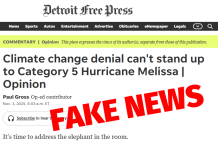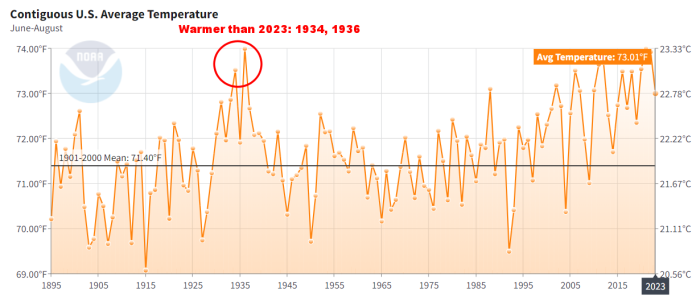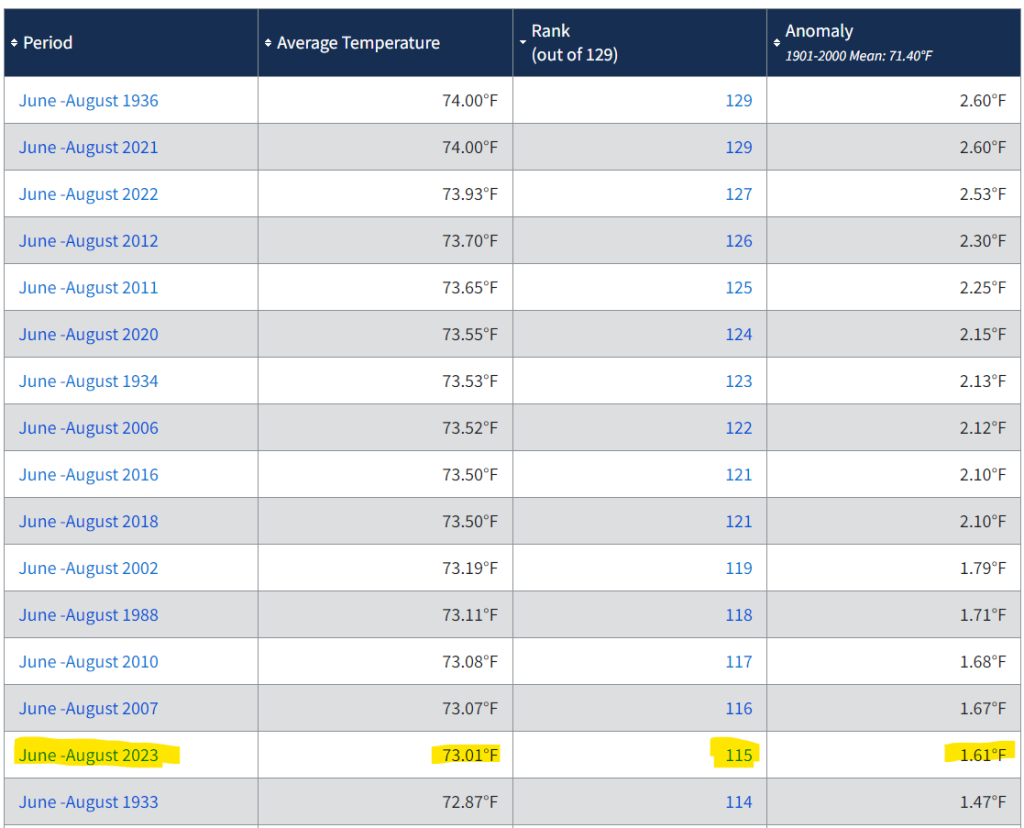Guest essay by Dr. ROY SPENCER AND KEVIN DAYARATNA (originally published at Newsweek)
Bad news sells, and numerous media outlets have sensationalized the past summer as being the hottest on record. But the details behind the dramatic headlines are unremarkable, and certainly no reason to panic.
Yes, some parts of the world have experienced unusual warmth in recent years. And the satellite-based dataset that global warming skeptics often point to will likely see 2023 as the warmest year since the record began in 1979. But there is much more to these measures than meets the eye.
“Record warmth” in any given year is usually measured in mere fractions of a degree Fahrenheit. As global data from the National Oceanic and Atmospheric Administration suggest, for example, this summer’s “record” (averaged from June through August) warmth averaged only 0.43 degrees warmer than in 2019 and 2020, the next-warmest years.
The small difference in average temperature also comes with wide variation, which makes climate change considerably more nuanced than usually reported by the mainstream media.
The pattern of regional surface temperature departures from the 30-year averages for the three months ending on September 9, 2023 over the Northern Hemisphere show areas of above-normal and below-normal temperatures. These 90-day temperature anomalies are based on computer model analysis of all available weather data from surface thermometers, buoys, ships, weather balloons, satellites, aircraft, and any other relevant sources. The “anomalies” are the differences between the temperature and what a model determines to be “normal.” This dataset, compiled by WeatherBell Analytics, found that Texas, Alaska, and parts of Canada have indeed been warmer, while many other U.S. states as well as a number of European countries have not seen a meaningful increase.
U.S. temperature data do not support reports of a record heat wave. Looking at just the surface thermometer data in the United States for June, July, and August of this year, this summer ranked as only the 15th warmest since 1895. Two of the years warmer than 2023 were before 1940. (See the graphic at the top of the article and the table below.)
Sadly, the field of climate science has been and continues to be unnecessarily politicized. For example, after several Italian researchers published a peer-reviewed paper last year questioning hyperbolic claims of a climate crisis, outraged ideologues and vested interests bullied the journal into retracting the paper. Another researcher recently indicated that he needed to “le[ave] out the full truth” for his paper to fit one peer-reviewed journal’s narrative about climate change.
Some argue that even if there is a remote chance that doom-and-gloom climate projections are true, we should move toward complete decarbonization to save the planet. But these policies will have significant economic consequences and negligible environmental effects. For example, the Green New Deal, which is still a policy goal for some Democrats, would reduce household income by at least $165,000 over a 20-year time horizon. The story is quite similar for President Joe Biden‘s climate agenda as well.
Even taking alarmist assumptions about the planet’s sensitivity to CO2 emissions at face value, if the United States were to eliminate fossil fuel consumption immediately, the policies would result in less than 0.2 degrees Celsius of temperature mitigation by 2100. This is because other countries, including China, will continue to pump out CO2 into the atmosphere, as they have been doing for years.
Sensationalized headlines based on cursory analysis fail to help anyone. And policies that, on the basis of these headlines, require use of renewables, eliminate certain types of appliances and cars, or impose a carbon tax will only reduce economic growth, rendering America less capable of weathering (no pun intended) any adverse events that come our way.
Roy Spencer is a Principal Research Scientist at the University of Alabama in Huntsville, and co-developer of the first method for monitoring global temperatures from Earth-orbiting satellites. Kevin Dayaratna is Chief Statistician, Data Scientist, and Senior Research Fellow at The Heritage Foundation
























This is
All about control of the narrative and climate chaos deniers spoil their outright distortions! These alarmist activists have no credibility whatsoever and should be treated with contempt rather than respectability! All data sources need to be scrutinized and scrubbed for accuracy and reliability!
Warming is good. Millions more people die from cold or cool weather than from hot or warm weather.
This recent study shows that the cold weather we have every year causes about 4.6 million deaths a year globally mainly through increased strokes and heart attacks, compared with about 500,000 deaths a year from hot weather. We can’t easily protect our lungs from the cold air in the winter and that causes our blood vessels to constrict causing blood pressure to increase leading to heart attacks and strokes.
‘Global, regional and national burden of mortality associated with nonoptimal ambient temperatures from 2000 to 2019: a three-stage modelling study’
https://www.thelancet.com/journals/lanplh/article/PIIS2542-5196(21)00081-4/fulltext
This article from 2015 says that cold weather kills 20 times as many people as hot weather and that moderately warm or cool weather kills far more people than extreme weather. Increased strokes and heart attacks from cool weather are the main cause of the deaths.
‘Mortality risk attributable to high and low ambient temperature: a multi-country observational study’ https://www.thelancet.com/journals/lancet/article/PIIS0140-6736(14)62114-0/fulltext
The Earth is still in a 2.56 million-year ice age named the Quaternary Glaciation in a still cold interglacial period that alternates with very cold glacial periods.
Everybody outside of the tropics still has to live in warm houses, wear warm clothes and shoes, work in warm offices and factories, and use warm transportation most of the year.